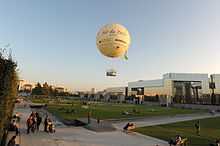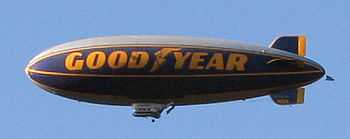Aerostat

An aerostat (From Greek ἀήρ aer (air) + στατός statos (standing) through French) is a lighter than air craft that gains its lift through the use of a buoyant gas. Aerostats include unpowered balloons and powered airships. A balloon may be free-flying or tethered. An aerostat's main component is one or more gasbags, a lightweight skin containing a lifting gas[1][2] to provide buoyancy, to which other components such as a gondola containing equipment or people are attached. Especially with airships, the gasbags are often protected by an outer envelope. One of the most recent deployments of an aerostat was seen at the opening ceremony of the nineteenth 2010 Commonwealth Games, held in Delhi, India. The aerostat used in the ceremony was the largest in the world.
Aerostats are so named because they use aerostatic lift which is a buoyant force that does not require movement through the surrounding air mass. This contrasts with the heavy aerodynes that primarily use aerodynamic lift which requires the movement of a wing surface through the surrounding air mass. The US Government Accountability Office has used the term "aerostat" in a different sense, to distinguish the statically tethered balloon from the free-flying airship.[3]
Terminology
In conventional usage, the term aerostat refers to any aircraft that remains aloft primarily using aerostatic buoyancy.[4][5] In a narrower sense, the term has also been used to refer to the statically tethered or moored balloon in contrast to the free-flying airship.[6] Moored means on a platform; tethered means secured to one location and not manned or flight-controlled. This article uses the term in its broader sense.
Types
Tethered balloons

A tethered balloon is one which is anchored in one place by one or more tethers. A round balloon is unstable and bobs about in strong winds, so the kite balloon was developed with an aerodynamic shape similar to a non-rigid airship. Both kite balloons and non-rigid airships are sometimes called "blimps".[5][7] Tethered balloons are used for many purposes, including military, border protection, sight seeing and advertising. Notable uses of tethered balloons include observation balloons and barrage balloons.
Free balloons
Free-flying buoyant aircraft that move by being carried along by the wind. Types of free balloons include hot air balloons and gas balloons.
Airships
Free-flying buoyant aircraft that can be propelled and steered. Some airships obtain aerodynamic lift via the shape of their envelope or through the addition of fins or other shape. These types of craft are called hybrid airships. In the past they were sometimes filled with hydrogen, which is explosive. But modern airships are filled with hot air or helium which is not explosive.
Hybrid aerostats
A hybrid type uses both static buoyancy and dynamic airflow to provide lift. The dynamic movement may be created either using propulsive power as a hybrid airship or by tethering in the wind like a kite, as a kytoon.
Piasecki Helicopter developed the Piasecki PA-97 Helistat using the rotor systems from four obsolete helicopters and a surplus Navy blimp, in order to provide a capability to lift heavier loads than a single helicopter could provide. The aircraft suffered a fatal accident during a test flight. In 2008, Boeing and SkyHook International resurrected the concept and announced a proposed design of the SkyHook JHL-40.
The Allsopp Helikite is a combination of a helium balloon and a kite to form a single, aerodynamically sound tethered aircraft, that exploits both wind and helium for its lift.
Gallery
-

Tethered balloons can carry instruments and sensors for long durations that are impractical for other aircraft.
-

Free balloons are free moving, unpowered aerostats. The above is a hot air balloon. There are also gas balloons.
-

Airships are free flying aerostats that can be propelled and steered.
See also
References
- ↑ The Chambers Dictionary. Edinburgh: Chambers Harrap Publishers Ltd. 2000 [1998]. p. 541. ISBN 0-550-14000-X.
the gas-bag of a balloon or airship
- ↑ The Oxford Illustrated Dictionary. Great Britain: Oxford University Press. 1976 [1975]. p. 281.
fabric enclosing gas-bags of airship
- ↑ "GAO-13-81, DEFENSE ACQUISITIONS: Future Aerostat and Airship Investment Decisions Drive Oversight and Coordination Needs" (PDF). Retrieved 2013-06-15.
- ↑ Green, W.; The observer's world aircraft directory, Warne (1961)
- ↑ 5.0 5.1 Wragg, D.; Historical dictionary of aviation, History Press (2008).
- ↑ "GAO-13-81, DEFENSE ACQUISITIONS: Future Aerostat and Airship Investment Decisions Drive Oversight and Coordination Needs" (PDF). Retrieved 2013-06-15.
- ↑ Ege, l.; Balloons and Airships, Blandford 1973
External links
- Airship resources
- Aerophile web page
- Tactical Aerostats
- Raven Aerostar web page
- DJ's Zeppelin page
- "Illustrations of the Five Major Types of Lighter-Than-Air-Aircraft" Popular Mechanics, June 1930
- The principle of a balloon flight - VIDEO
| ||||||||||||||||||||||||||||||||||